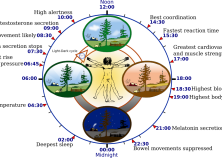Chronobiology and obesity: Interactions between circadian rhythms and energy regulation.

Recent advances in the understanding of the molecular, genetic, neural, and physiologic basis for the generation and organization of circadian clocks in mammals have revealed profound bidirectional interactions between the circadian clock system and pathways critical for the regulation of metabolism and energy balance. The discovery that mice harboring a mutation in the core circadian gene circadian locomotor output cycles kaput (Clock) develop obesity and evidence of the metabolic syndrome represented a seminal moment for the field, clearly establishing a link between circadian rhythms, energy balance, and metabolism at the genetic level. Subsequent studies have characterized in great detail the depth and magnitude of the circadian clock’s crucial role in regulating body weight and other metabolic processes. Dietary nutrients have been shown to influence circadian rhythms at both molecular and behavioral levels; and many nuclear hormone receptors, which bind nutrients as well as other circulating ligands, have been observed to exhibit robust circadian rhythms of expression in peripheral metabolic tissues. Furthermore, the dailytiming of food intake has itself been shown to affect body weight regulation in mammals, likely through, at least in part, regulation of the temporal expression patterns of metabolic genes. Taken together, these and other related findings have transformed our understanding of the important role of time, on a 24-h scale, in the complex physiologic processes of energy balance and coordinated regulation of metabolism. This research has implications for human metabolic disease and may provide unique and novel insights into the development of new therapeutic strategies to control and combat the epidemic of obesity.
Summa KC, Turek FW et Al.
Adv Nutr. 2014 May 14;5(3):312S-9S.


